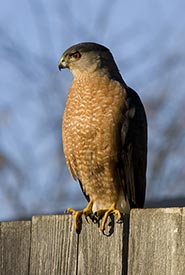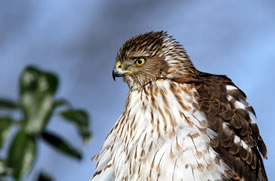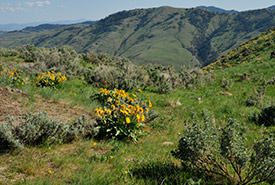Tales of recovery: Cooper's hawk

Cooper's hawk (Photo by Jim Johnson, CC BY-NC-ND 4.0)
Not that long ago, we used the “Santa Claus method” to classify wildlife. There was the nice list. Animals like deer and trout and ducks were on that list. These were mostly animals that we liked to hunt and fish, but also animals that were considered beneficial, such as the birds that ate the bugs that ate our crops.
The naughty list mostly included animals that ate the animals that we like to eat. Wolves were near the top of that list, but so were foxes, bears, loons, orcas and hawks. One hawk was particularly hated, as it ate our chickens. It was often given the unofficial name of chicken-hawk. Today we call it the Cooper’s hawk.
Quick facts at a glance
Status in Canada
1930: declining
1983: rare
1996: not at risk
What worked?
Changing attitudes about hawks, adaptation to new habitats

Cooper's hawk (Photo by Bill Hubick)
It’s difficult to ascertain the historic status of the Cooper’s hawk. Most accounts up until the 1950s simply advocate for fewer of them. Bird books called them “a very destructive hawk” in the early 1900s, “a menace” in the 1920s and “the most destructive species that we have to contend with” in the 1930s. Even Jack Miner, a Canadian conservation heroe who pioneered bird banding, didn’t like them. While he advocated for more nature reserves, he also advocated for fewer hawks.
But almost a century ago, there was a growing concern from bird enthusiasts and scientists about the decline of hawks. In 1931, the Brodie Nature Club took on Miner's claims about hawks and advocated for their protection. Slowly, our attitudes toward birds of prey began to change. A growing number of people began to dispel the old stereotypes about wildlife that were on the naughty list and appreciate the important role and beauty of nature’s predators.
By the 1970s, while indiscriminate shooting had decreased, Cooper’s hawk continued to decline. This was likely a result of DDT. This pesticide accumulated in the bodies of hawks and other species near the top of the food chain and reduced their chances of reproducing. In the 1970s, Cooper’s hawk was placed on the National Audubon Society's Blue List. In 1983, the Committee on the Status of Endangered Wildlife assessed it as rare.
But the fortune of Cooper’s hawk began to change by the 1980s. With DDT banned and the shooting of hawks unthinkable to most people, its numbers were beginning to increase. By 1996, it had been reassessed as not at risk in Canada.

Sage and Sparrow Conservation Area, BC (Photo by NCC)
Today, Cooper’s hawks are common. Where I live in Ontario, there has been an astonishing increase in the species' range. It has been documented on over 50 Nature Conservancy of Canada properties, stretching from BC’s Sage and Sparrow Conservation Area to the Alfred-Kelly Nature Reserve in Quebec.
But now you don’t even need to leave your local community or even your backyard to see it. This bird that was historically a bird of forests has adapted to urban environments. It’s not uncommon to see a flock of mourning doves or black-capped chickadees suddenly fly off from a bird feeder as a Cooper’s hawk swoops in, looking for a meal.
Our changing society has played an important role in the recovery of the Cooper’s hawk. Most of our chickens are now raised inside massive barns. We also have very different habitats in our Canadian cities now. We feed birds and have mature trees in urban areas that have created a new blend of habitat that suits the needs of the Cooper’s hawk.
But its success also reflects a change in our attitudes toward the other species that share our spaces. Over the last few decades, we have transitioned toward a greater appreciation of the intrinsic values of wildlife — of their right to exist regardless of the benefits they perceive to provide people.
A key part in the recovery of Cooper’s hawk is its adaptability. Even just a few decades ago, seeing a Cooper’s hawk in an urban area would have been extraordinary. There are many species that were once rare, ranging from sea lions to peregrine falcons, that have shown to be very adaptive, provided we give them some space to co-exist and reduce factors that once caused their direct mortality.
The ability of wildlife to adapt to new conditions shouldn’t be underestimated. In a rapidly changing world, we need to both reduce threats and give wildlife all the habitat we can to help them adapt to the new ecological normal we are creating through our human activities.
Resources
Nash, C.W., Manual of the Vertebrates of Ontario. 1908, Toronto: Department of Education.
Taverner, P., Birds of western Canada. Canada Department of Mines, Victoria Memorial Museum. Bulletin, 1928(41).
Pearson, T., Birds of America. 1936, Garden City, NY: Garden City Publ. Co.
The Brodie Club, The Brodie Club Examines Jack Miner's 'Facts About Hawks. 1931, The Brodie Club: Toronto. p. 4.
Arbib, R., Announcing—the blue list:“an early warning system” for birds. American Birds, 1971. 25: p. 948-949.
Manfredo, M.J., Sullivan, L., Don Carlos, A. W., Dietsch, A. M., Teel, T. L., Bright, A. D., & Bruskotter, J., America’s Wildlife Values: The Social Context of Wildlife Management in the U.S. 2018, National report from the research project entitled “America’s Wildlife Values.” Fort Collins, CO: Colorado State University, Department of Human Dimensions of Natural Resources.


